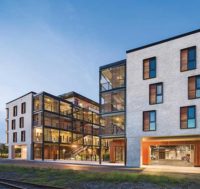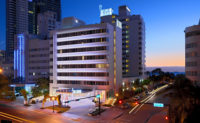Since it was established 349 years ago, Charleston, South Carolina, has amassed a well-preserved sampling of architectural styles from the Colonial, Victorian and Classic Revival periods. So when San Francisco-based David Baker Architects (DBA) partnered with local firm McMillan Pazdan Smith (MPS) to design Willliams Terrace, a 41-apartment complex for residents age 62 and older, it was clear that in addition to modern convenience (flood-resistance was part of the brief in this low-lying coastal city), the design should also evoke some Charleston charm.
To achieve this, DBA principal Daniel Simons found inspiration in a long, narrow 19th century building type that’s almost unique to Charleston. Always one room wide with a covered porch on one long side, the townhouse is affectionately known as the Charleston Single House. In fact, the prevalence of balconies on these buildings figures prominently in what Simons calls “a huge porch culture in the South.”

For practical reasons, the solution was not exactly duplication of the past: The new 47,851-square-foot, four-story structure is U-shaped and wraps around a landscaped central courtyard, giving all the units access to a verdant view. To protect residents in this high-velocity flood zone, the team placed no apartments on the ground floor. Instead they created an enormous community room on that level—a multipurpose space that can also serve as a buffer in case of emergencies by withstanding flood waters up to 14 feet high. (This strategy was especially critical because the site was previously occupied by an affordable housing complex that was destroyed in 1989 during hurricane Hugo.) The apartment complex also opens onto a sidewalk that borders a recently renovated park.
In a nod to the historic Charleston cityscape, bricks used for the facade are lime-washed. On each of the units on the three upper levels, apartment doors lead to open-air corridors that run uninterrupted around the U shape and overlook the central courtyard below. Viewed from the street and punctuated with rocking chairs, the long wrap-around corridors echo piazzas of the city’s traditional “Single Houses.” In a further nod to the neighborhood’s context, DBA worked with Southeastern Architectural Systems to add operable, louvered porch screens, mounted on an aluminum track. Not only do the floor-to-ceiling 2” by 2” wood slats provide shade, but they also recall the style of the classic buildings, as do ventilating ceiling fans placed at intervals along the outdoor ceilings. Residents can easily walk along these porches to visit one another. “We were trying to find a way to make the piazzas have a communal quality to them,” Simons explains.
This story was featured in Material World, Architectural Record’s products-focused newsletter. Subscribe today!











Post a comment to this article
Report Abusive Comment